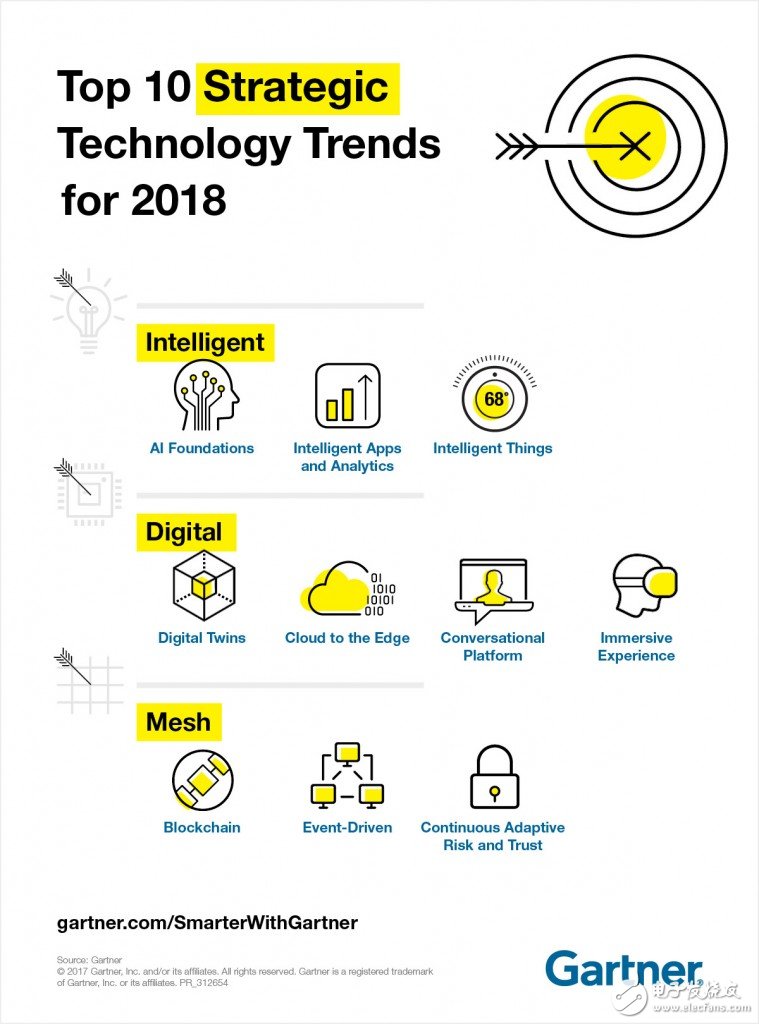Technology is continuously enhancing our daily lives, and the best approach is to keep up with the fast-paced developments of modern society. As fields like AI, IoT, and immersive experiences continue to advance, it's essential to stay connected with these promising technologies. By doing so, we can better anticipate future changes and innovations. This article explores the top ten technology trends that were worth paying attention to in 2018—let’s dive in!
**The Most Important Technology Trends of 2018**

As you can see, these top ten trends are mainly focused on artificial intelligence, digital transformation, and networking. If you want to understand more about these groundbreaking technologies, keep reading below.
**1. AI Foundations (AI Foundations)**
According to a Gartner report, approximately 59% of organizations were still in the early stages of gathering data to build their AI strategies in 2018. It was expected that by this year, AI would play a growing role in improving decision-making, customer experience, and business models. The integration of AI into daily operations was becoming more common across industries.
**2. Intelligent Apps and Analytics (Intelligent Apps and Analytics)**
In the coming years, every application and service was expected to incorporate some level of AI technology. By 2018, most smartphones were predicted to include dedicated AI chips, making AI an invisible but essential part of our lives. These smart applications would create a new “smart layer†between users and systems, changing how we work and interact. Enhanced analytics powered by AI also became a crucial component for enterprises.
**3. Intelligent Things (Intelligent Things)**
AI and machine learning helped smart devices interact more naturally with people and their environments. Devices like Amazon Echo and Google Home were already transforming homes, and as more smart devices emerged, they would either operate independently or be controlled by users.
**4. Digital Twins**
Digital twins involve creating digital representations of physical assets using advanced sensors and real-time data. This concept allows companies to monitor and analyze the performance of physical objects, such as machines or buildings. A digital twin is not a biological clone, but rather a data-driven model that mimics real-world behavior. By 2020, it was estimated that over 21 billion connected sensors would be in use, offering significant benefits for marketers, healthcare professionals, and planners.
**5. Cloud to the Edge**
Edge computing involves processing data closer to where it’s generated, rather than sending it all to the cloud. This approach helps reduce latency and improve response times. While cloud computing remains important, edge computing complements it by enabling faster, more efficient data processing at the source. Together, they support real-time business needs and enhance security and privacy.
**6. Conversational Platforms (Conversational Platform)**
“Conversational as a Platform†refers to a new way of human-computer interaction, moving beyond graphical interfaces to natural language conversations. These platforms allow users to interact with systems through dialogue, making it easier to find information, access services, and perform tasks. As these platforms evolve, they will become even more capable of handling complex interactions.
**7. Immersive Experiences**
Technologies like VR, AR, and MR are designed to create more engaging and realistic user experiences. Mixed Reality combines both virtual and real elements, allowing digital and physical objects to coexist and interact in real time. Companies like Microsoft, Apple, and Google were investing heavily in these technologies, signaling a shift toward more interactive and immersive digital environments.
**8. Blockchain**
Blockchain is the foundational technology behind Bitcoin and has gained significant attention in recent years. Although its association with cryptocurrency has led to regulatory challenges, its potential for secure, transparent, and decentralized systems cannot be ignored. In 2018, blockchain was seen as one of the most promising technologies, with increasing applications in various industries.
**9. Event-Driven**
Event-driven systems are critical for businesses, as they help detect and respond to key changes quickly. With the rise of AI and IoT, event detection became more accurate and timely. By 2020, it was expected that 80% of digital business solutions would rely on event-based thinking to improve efficiency and responsiveness.
**10. Continuous Adaptive Risk and Trust (CARTA)**
As cyber threats became more sophisticated, organizations needed better ways to manage risks and trust. CARTA allowed businesses to assess risks in real time and adapt accordingly. Integrating security into DevOps processes created a more secure and agile development environment, known as DevSecOps.
These trends highlighted the rapid evolution of technology and its deep impact on our personal and professional lives. Understanding them was key to staying ahead in the digital age.
DELL chromebook 11 3110, dell chromebook 3110, ddell chromebook 3110 2-in-1
S-yuan Electronic Technology Limited , https://www.syuanelectronic.com